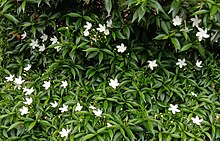Tabernaemontana divaricata
| Tabernaemontana divaricata | |
|---|---|

| |
| Scientific classification | |
| Kingdom: | Plantae |
| Clade: | Tracheophytes |
| Clade: | Angiosperms |
| Clade: | Eudicots |
| Clade: | Asterids |
| Order: | Gentianales |
| Family: | Apocynaceae |
| Genus: | Tabernaemontana |
| Species: | T. divaricata
|
| Binomial name | |
| Tabernaemontana divaricata R.Br. ex Roem. & Schult.
| |
| Synonyms[2] | |
|
List
| |
Tabernaemontana divaricata, commonly called pinwheel flower,[3] crape jasmine, East India rosebay, and Nero's crown,[4] is an evergreen shrub or small tree native to South Asia, Southeast Asia and China.[1] In zones where it is not hardy it is grown as a house/glasshouse plant for its attractive flowers and foliage. The stem exudes a milky latex when broken, whence comes the name milk flower

Description
The plant generally grows to a height of 1.5–1.8 metres (5–6 ft) and is
genera in the family Apocynaceae such as Vinca and Nerium. Both single and double-flowered forms are cultivated, the flowers of both forms being white. The plant blooms in spring but flowers appear sporadically all year. The flowers have a pleasing fragrance.[5] More than 66 alkaloids are found in the shrub.[6] Its habitats include montane brushwoods and sparse forests.[7]
-
Tabernaemontana divaricata 'Flore Pleno'
-
Crape jasmine bunch
-
Tabernaemontana divaricata 'Pinwheel'
-
Tabernaemontana divarcata yet to blossom
-
Caterpillar of Oleander hawk-moth feeding on pinwheel flower plant
-
Flower buds of crape jasmine at night
Phytochemistry
The species is known to produce many
alkaloids including catharanthine, coronaridine, dregamine, ibogamine, tabersonine, voacangine, voacamine and voacristine.[8] Ibogaine may occur in multiple Tabernaemontana species.[8]
Research
There is presence of potent
galanthamine.[10]
See also
References
- ^ . Retrieved 19 November 2021.
- ^ "Tabernaemontana divaricata (L.) R.Br. ex Roem. & Schult". Plants of the World Online. Board of Trustees of the Royal Botanic Gardens, Kew. 2017. Retrieved 7 September 2020.
- ^ USDA, NRCS (n.d.). "Tabernaemontana divaricata". The PLANTS Database (plants.usda.gov). Greensboro, North Carolina: National Plant Data Team. Retrieved 7 December 2015.
- ^ Medicinal Plants of India and Pakistan, Dastur J.F., pub.1962 by D.P. Taraporevala Sons and Co. Private Ltd., Mumbai, 4th Indian reprint 1977[page needed]
- ISBN 0-19-869106-8
- ISBN 978-0-262-16076-6.[page needed]
- ^ "Tabernaemontana divaricata in Flora of China @ efloras.org". www.efloras.org. Retrieved 2022-09-27.
- ^ S2CID 12805328.
- PMID 23375813.
- S2CID 37975644.
External links
 Data related to Tabernaemontana divaricata at Wikispecies
Data related to Tabernaemontana divaricata at Wikispecies Media related to Tabernaemontana divaricata at Wikimedia Commons
Media related to Tabernaemontana divaricata at Wikimedia Commons







